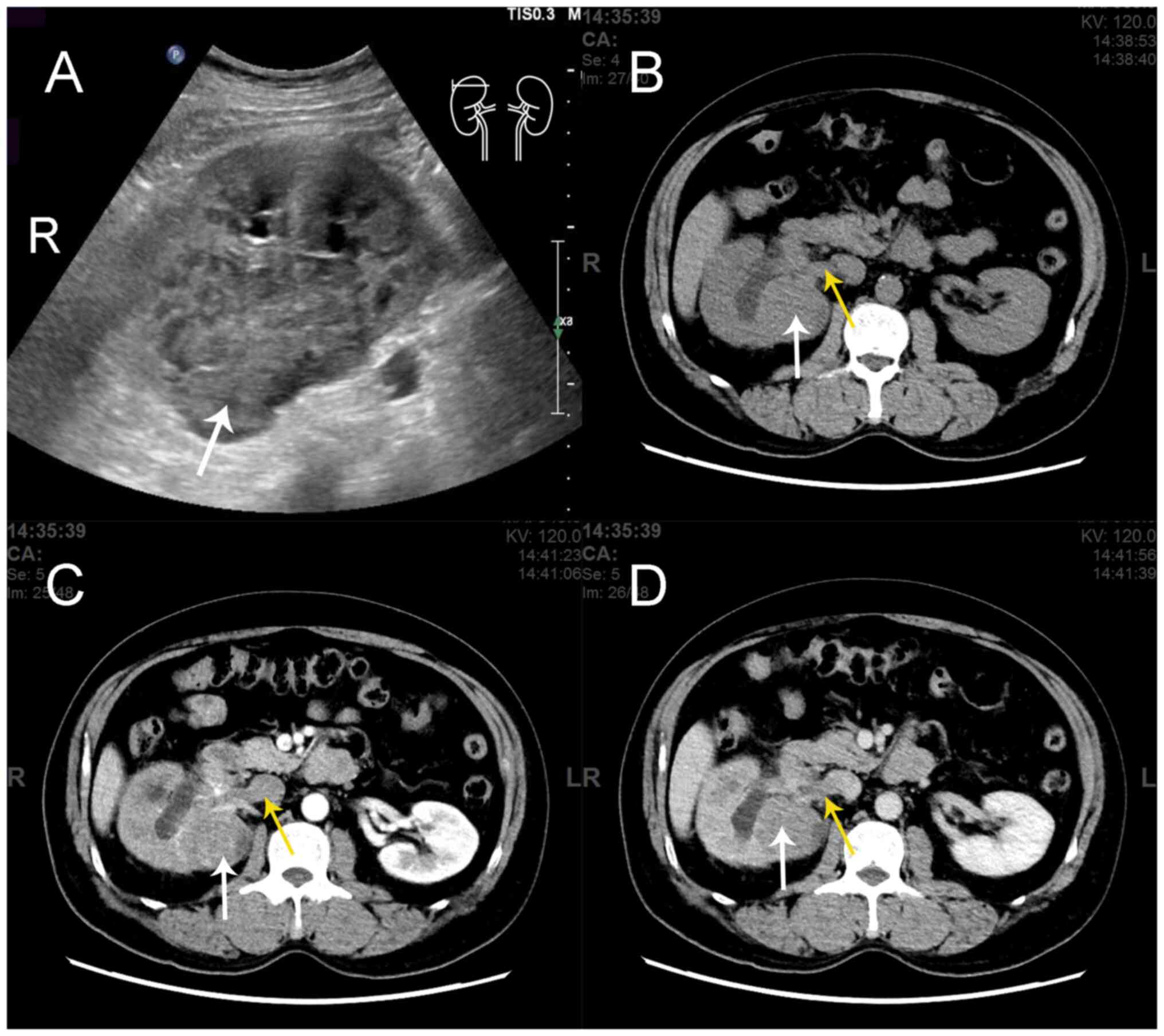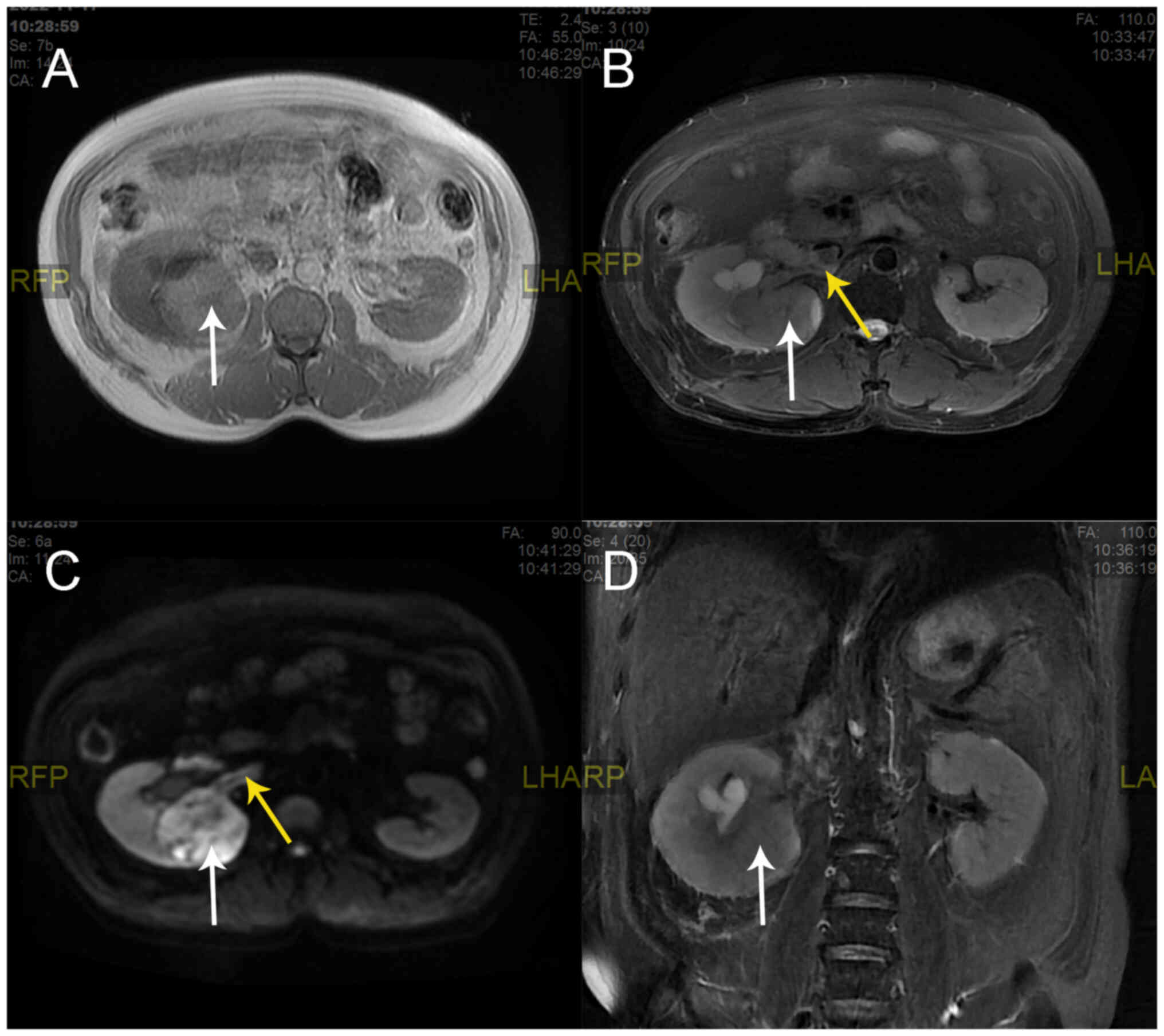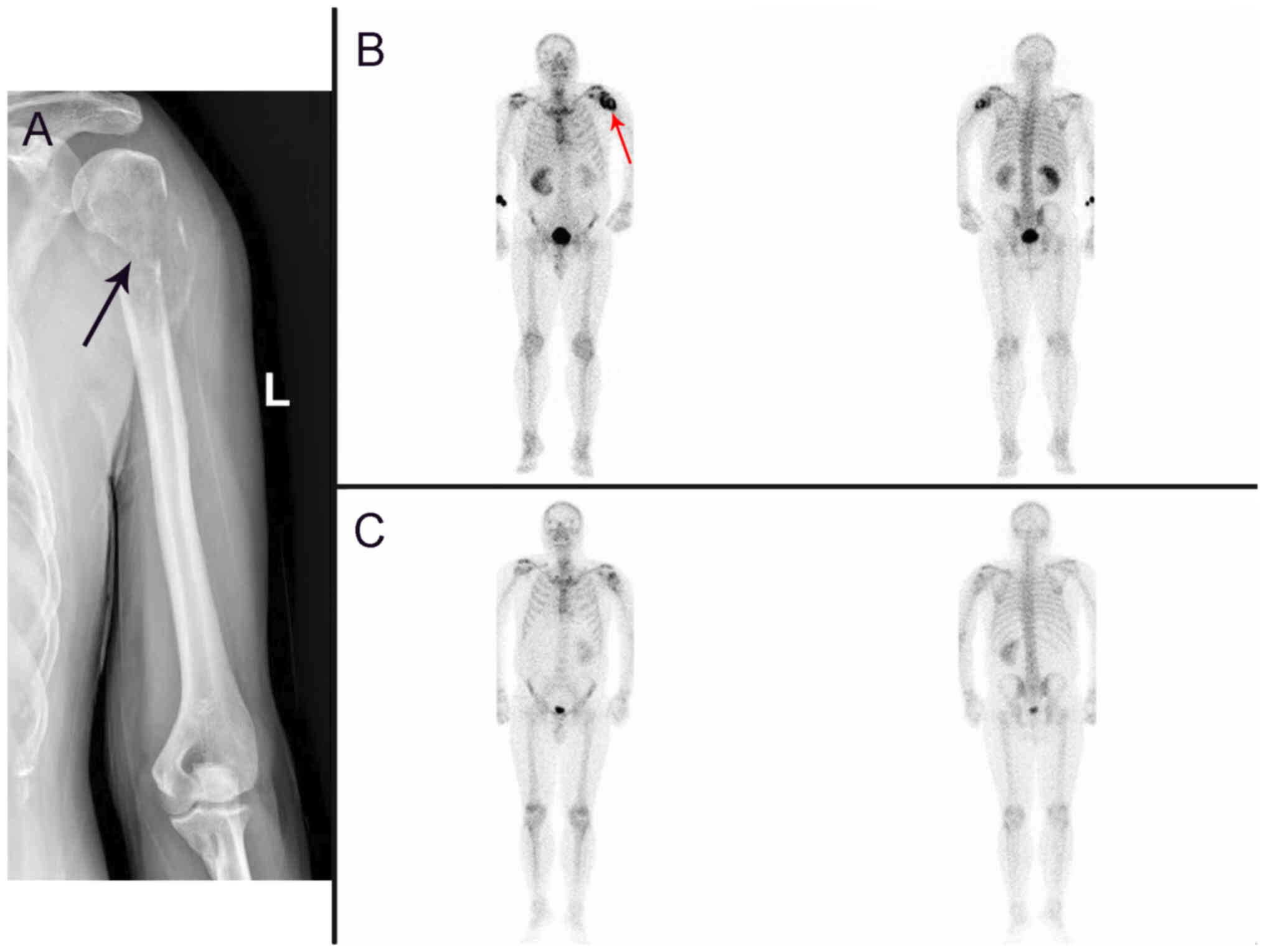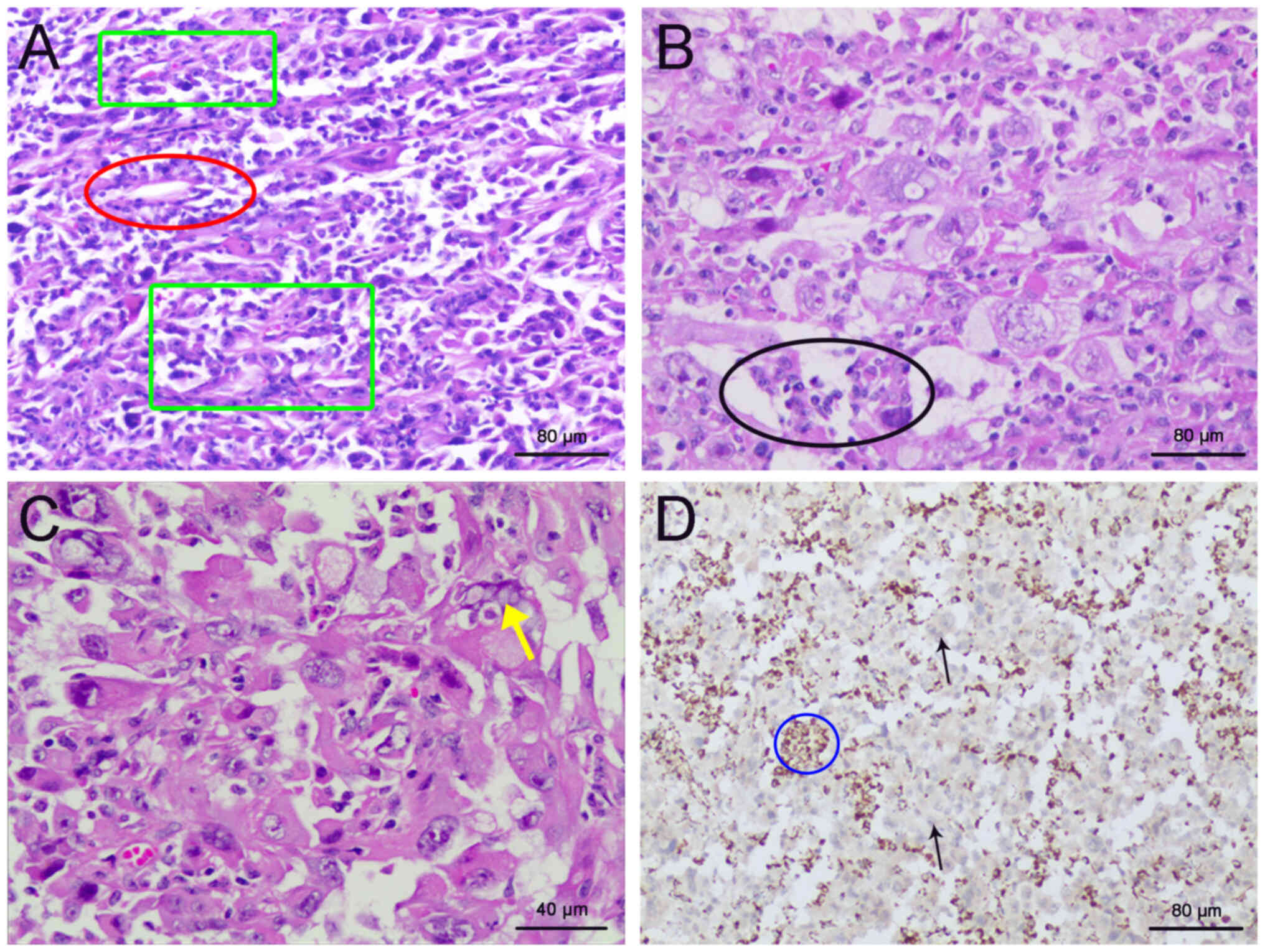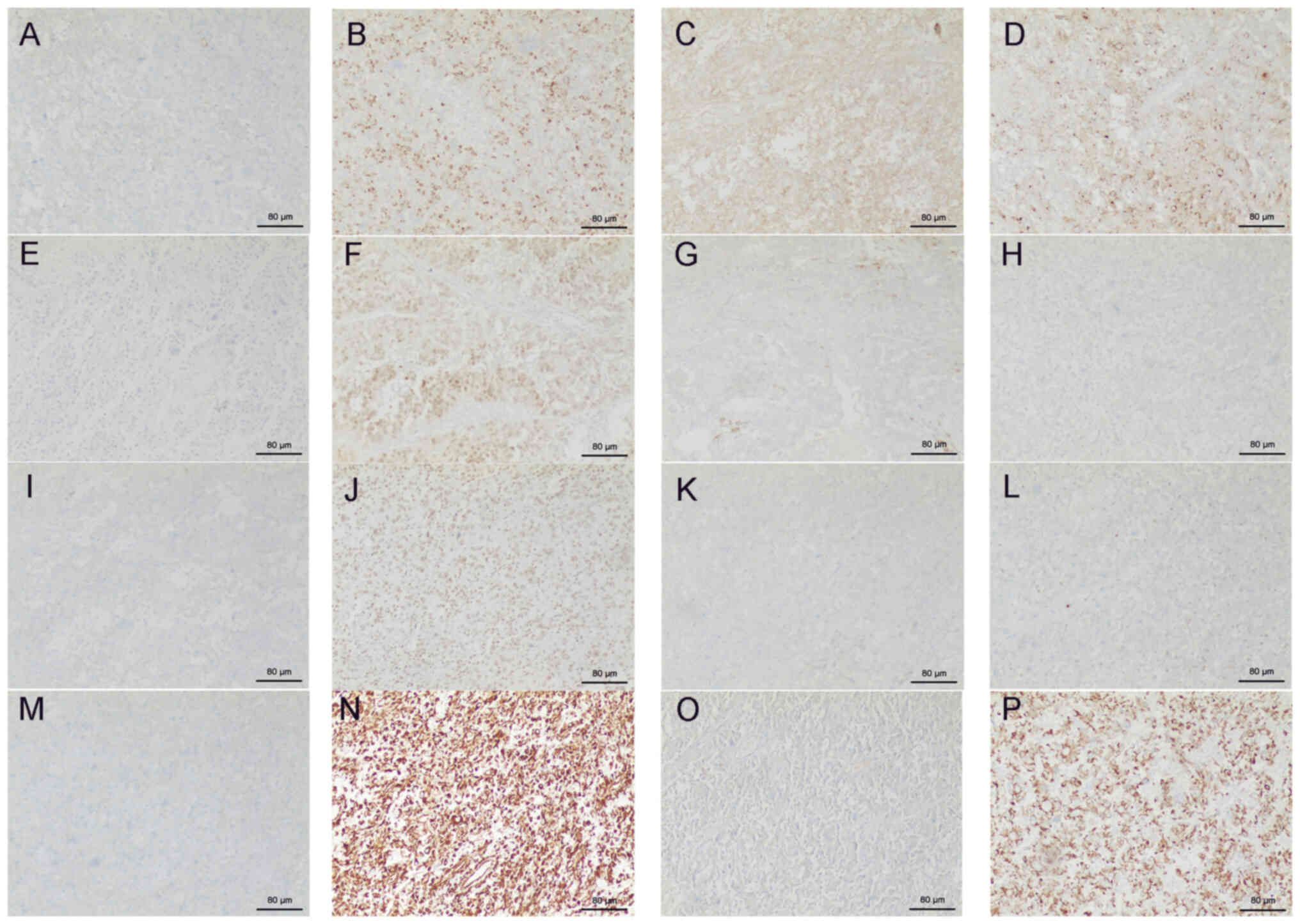A highly malignant succinate dehydrogenase A‑deficient renal cell carcinoma with bone metastasis misdiagnosed as hereditary leiomyomatosis and renal cell carcinoma: A case report
- Authors:
- Published online on: June 3, 2024 https://doi.org/10.3892/ol.2024.14485
- Article Number: 351
-
Copyright: © Dai et al. This is an open access article distributed under the terms of Creative Commons Attribution License.
Abstract
Introduction
Succinate dehydrogenase (SDH)-deficient renal cell carcinoma (RCC) is a rare form of RCC that has a hereditary component (1). Renal cancer, a common tumor of the urinary system, accounts for 2–3% of adult malignancies globally (2). However, SDH-deficient RCC accounts for 0.05–0.20% of all cases of renal cancer (3). This form of RCC is rare compared to more common subtypes such as clear cell RCC, which accounts for about 70–80% of all RCC cases. In 2004, Vanharanta et al (4) first reported SDH-deficient RCC. SDH-deficient RCC was subsequently included as a new subtype of RCC in the 2016 edition of the World Health Organization classification of renal tumors (5).
SDH-deficient RCC is an autosomal dominant disease caused by an SDH gene mutation. SDH, also known as mitochondrial complex II, is formed from four protein subunits [SDH complex flavoprotein subunit A (SDHA), SDHB, SDHC and SDHD], which is involved in the tricarboxylic acid cycle and the respiratory electron transport chain (6,7). The function of SDH is to catalyze the energy-dependent conversion of succinate to fumarate (6). The four subunits are encoded by four genes respectively, and mutations in any one of the genes could cause the decrease, and even loss, of SDH activity (8), which results in the intracytoplasmic accumulation of succinate and potentially predisposes patients to neoplastic transformation (9,10). SDHB mutations are the most common, followed by SDHC and SDHA mutations (1). SDHD mutations are rare compared with other mutations, and ~30% are multifocal or bilateral renal tumors (3,5,11). Studies have reported that succinate, the catalytic substrate of SDH, is involved in signal transduction pathways in renal cell cancer (7–9,12), but the exact mechanism of the SDH gene mutation that leads to tumorigenesis is currently unclear. Mutations in the SDH gene are also associated with certain types of hereditary tumors, such as pheochromocytomas, gastrointestinal stromal tumors, familial paragangliomas and partial pituitary adenomas (13,14).
SDH-deficient RCC is more commonly diagnosed in young adults (age, 22 to 72 years) and slightly more prevalent in men (3,11). The diagnosis of SDH-deficient RCC relies upon pathology, immunohistochemistry (IHC) and genetic testing (3). Macroscopically, the tumors are well-circumscribed, with mass or cystic growth that is grayish-red or grayish-brown in appearance and can be accompanied by hemorrhage. Microscopically, the tumor cells typically appear cuboidal or oval and are arranged in nests or tubules, often exhibiting cystic changes (15). The tumor cells typically have round or oval nuclei, scattered flocculent chromatin and inconspicuous nucleoli (13,15). The most prominent histological feature of SDH-deficient RCC is the presence of cytoplasmic vacuoles or inclusion bodies (13).
The present study reported the case of a 49-year-old patient with a highly malignant tumor who developed distant bone metastasis upon initial examination. The postoperative pathological diagnosis was at first unclear and, in combination with the patient's clinical manifestations and imaging data, hereditary leiomyomatosis and RCC syndrome (HLRCC) was considered. Finally, genetic screening identified a germline mutation in the SDHA gene, and IHC demonstrated loss of SDHB expression. The imaging and pathological data of the patient were similar to that of HLRCC and differential diagnosis was challenging. To the best of our knowledge, misdiagnosed with HLRCC due to microscopic resemblance, but genetic testing later revealed an SDHA mutation, confirming SDHA-deficient RCC, which has not been reported before and emphasizes the necessity for further genetic screening.
Case report
The present report was conducted in accordance with the Surgical CAse REport guidelines (16). A 49-year-old male patient presented to Linyi People's Hospital, Linyi, China) in November 2022 with a soft-tissue mass on his right kidney, detected by B-mode ultrasound imaging during a health check-up (Fig. 1). The patient had a history of fractures, with a left humerus fracture occurring 1 month prior to admission due to minor external force, with no risk factors for malignancy and no family history of malignant disease. Upon physical examination, the patient demonstrated no abnormalities in both kidneys. Contrast-enhanced computed tomography (CT) scan indicated a 55×68 mm mass in the right kidney along with a filling defect in the right renal vein and inferior vena cava (Fig. 1), which was suspected to indicate an intravascular tumor thrombus. A renal magnetic resonance imaging (MRI) scan showed enlargement of the right kidney with abnormal round signals covering an area of 55×68 mm, which included a mixed, slightly high T1 weighted image (T1WI) signal, a mixed T2 weighted image (T2WI) signal and an inhomogeneous high diffusion-weighted imaging (DWI) signal (Fig. 2). The perirenal contour was well circumscribed. The right renal pyelectasis was accompanied by a patchy homogeneous T1 signal, a high T2 signal and DWI exhibited a high signal (Fig. 2). Digital radiography demonstrated discontinuity in the cortical bone at the proximal end of the left humerus (Fig. 3A). A whole-body bone scan demonstrated radionuclide accumulation at the upper end of the left humerus (Fig. 3B), which indicated possible pathological bone destruction.
The preoperative diagnosis was malignant tumor of the right kidney, accompanied by tumor cell emboli in the right renal vein and inferior vena cava. Subsequently, surgical resection of the tumor was performed. Pathological assessment was performed on the formalin-fixed, paraffin-embedded (FFPE) tissue block of surgical specimen stained with hematoxylin and eosin. Postoperative pathology demonstrated a high-grade RCC with lymphatic and vascular involvement, as well as invasion of the renal sinus but not perirenal fat (Fig. 4A and B). Microscopically, the tumor cells exhibited a mixed growth pattern arranged in nests, papillae and tubular cysts with prominent nucleoli, increased mitotic figures and marked nuclear atypia. Immunohistochemical analysis was conducted on formalin-fixed paraffin-embedded (FFPE) tissue blocks. Specimens were fixed in 10% neutral buffered formalin at room temperature for 16–24 h. Tumor sections, cut to a thickness of 4 µm, were deparaffinized and rehydrated through a series of solutions: xylene I for 15 min, xylene II for 15 min, 100% ethanol for 5 min, 95% ethanol for 5 min, 80% ethanol for 2 min, and 70% ethanol for 2 min. The sections were washed in phosphate-buffered saline (PBS) three times, each wash lasting 10 min. Antigen retrieval was performed in a pressure cooker using 0.01 M citrate buffer (pH 6.0) at 95°C for 10 min. Following this, the slides were washed three times with 0.01 M PBS (pH 7.4), each wash for 5 min. Endogenous peroxidase activity was blocked by incubating the slides with 3% hydrogen peroxide at 37°C for 30 min, followed by three PBS washes, each lasting 10 min.
Non-specific binding was blocked by incubating the sections with 10% goat serum (Fuzhou Maixin Biotechnology Development Co., Ltd.) at room temperature for 30 min, followed by three PBS washes, each for 10 min. Primary antibodies were applied at room temperature for 30 min and then at 4°C for 12 h. The primary antibodies used included Cytokeratin 7 (ZM-0071), α-methylacyl-coenzyme A racemase (ZA-0228), E-cadherin (ZM-0092), CD10 (ZM-0092), carbonic anhydrase IX (TA500623), Pax-2 (ZA-0467), CD117 (ZA-0523), Anaplastic Lymphoma kinase (ALK)-1A4/1H7 (ZM-0248), cytokeratin 20 (ZA-0574), integrase interactor 1 (ZA-0696), tumor protein 63 (ZM-0406), GATA binding protein 3 (ZA-0661), S100 calcium-binding protein P (ZM-0494), Vimentin(ZM-0260), and octamer-binding transcription factor 4 (ZM-0233). All primary antibodies were provided as ready-to-use formulations, requiring no further concentration or dilution, and were supplied by Beijing Zhongshan Golden Bridge Biotechnology Co., Ltd. Following incubation, the slides were brought to room temperature for 30 min and then washed three times with PBS, each wash for 10 min. A horseradish peroxidase-conjugated goat anti-rabbit IgG secondary antibody (ZB-5301, 1:5,000, provided by Beijing Zhongshan Golden Bridge Biotechnology Co., Ltd.) was added, and the slides were incubated at room temperature for 1 h. Diaminobenzidine (DAB) was used as the chromogen for visualization. The sections were counterstained with hematoxylin for 2 min at room temperature and then blued in ammonia water for 1 min, sealed with Permount Mounting Medium, and examined under a LEICA DM2000 light microscope. IHC demonstrated the following: Cytokeratin 7 (−), α-methylacyl-coenzyme A racemase (+), E-cadherin (+), CD10 (+), carbonic anhydrase IX (+), Pax-2 (+), CD117 (−), ALK-1A4/1H7 (−), cytokeratin 20 (−), integrase interactor 1 (+), tumor protein 63 (−), GATA binding protein 3 (−), S100 calcium-binding protein P (−), Vimentin (+), octamer-binding transcription factor 4 (−) and CK (+) (Fig. 5). The tumor stage was pT3bN0M1. Due to the microscopic appearance of the cancer cells closely resembling hereditary leiomyomatosis and renal cell carcinoma (HLRCC), and the characteristic markers of SDH-deficient RCC-cytoplasmic vacuolization or cytoplasmic inclusions-were difficult to identify in this case. Pathological examination could not confirm the diagnosis and HLRCC was considered. The diagnosis of HLRCC requires genetic sequencing for confirmation. Consequently, genetic testing was conducted on the patient.
In this case, high-throughput sequencing was performed. The sequencing process was contracted out to a certified company, ensuring high-quality and reliable data. The procedure employed high-throughput sequencing combined with targeted region capture technology. The DNA/RNA samples for sequencing were prepared using the MagPure Buffy Coat DNA Midi KF Kit, which is catalogued under D3537-02#; Magen Biotech. Agarose gel electrophoresis was employed to verify the quality/integrity of processed samples. The sequencing was executed using the MGISEQ-2000RS High-Throughput Sequencing Kit (catalog number 1000012554# (two-part), supplied by MGI. The kit supports paired-end sequencing (PE100+100+10). The sequencing strategy employed was paired-end sequencing, with a sequence length of 100 base pairs. Finally, the loading concentration of the final library was measured at 26.42 fmol/ul using the Qubit ssDNA Assay. Postoperative high-throughput sequencing was performed and indicated a mutation in the SDHA gene [c.1A>G (p. Met1?)]. On this basis, the disease was diagnosed as SDHA-deficient RCC. Human genetic counseling indicated that this specific mutation leads to the alteration of the protein translation start codon, resulting in a change to the initiation site of protein synthesis and ultimately impacting the function of the encoded protein.
In order to identify histopathological features and confirm the lack of SDHB expression in cancer cells, the pathological tissue excised from the patient was reprocessed into histological sections and subjected to hematoxylin & eosin (H&E) staining as well as IHC staining. The specimen was fixed using a 10% neutral buffered formalin solution. The fixation process was carried out at room temperature for a duration ranging from 16 to 24 h. The tissue sections were cut to a thickness of 4 µm. Following sectioning, the slides were stained using Harris hematoxylin solution. The staining was performed at room temperature and the sections were left in the stain for 5 min. After rinsing, the sections were counterstained with eosin for 1 min. Similar to hematoxylin application, the eosin staining process was also conducted at room temperature. The stained slides were examined under a light microscope. Due to the extremely scarce presence of vacuoles in paraffin-embedded specimens, they were very difficult to detect. Upon examination, the rare characteristic cytoplasmic vacuoles were identified (Fig. 4C). IHC for SDHB revealed its loss of expression (Fig. 4D).
The patient underwent radiotherapy and targeted therapy 1 month after the surgery. The patient is prescribed Sunitinib Malate capsules at a dosage of 50 mg daily, administered orally. The regimen consists of taking the medication continuously for 4 weeks followed by a 2-week break. Immediate discontinuation of the drug is advised in the event of severe adverse reactions. Targeted radiotherapy was administered to a metastatic lesion located at the upper end of the left humerus. The radiation field measured 12×9 cm with a depth of 8 cm. The treatment utilized a Source-to-Axis Distance (SAD) technique with anterior and posterior opposed fields, employing 6 MV X-rays. A total dose of 50 Gy was delivered over 25 fractions. The patient underwent three radiotherapy sessions. Chest and abdominal CT scans performed 3 months after the surgery showed no signs of metastasis while a whole-body bone scan demonstrated reduced radionuclide concentration at the upper end of the left humerus (Fig. 3C). At the time of writing (July 2023), the patient was under observation for 6 months and their condition remained stable.
Discussion
In the present case, the patient was diagnosed with a right renal mass during a health check-up without any particular clinical symptoms, and no tumor was identified in other parts of the body during preoperative examination, therefore secondary SDH-deficient RCC was excluded. The patient was postoperatively diagnosed with SDH-deficient RCC with tumor emboli and bone metastasis following identification of an SDHA germline mutation by genetic screening. To the best of our knowledge, this is the first report of such a case according to a search using MEDLINE via PubMed using the terms ‘SDHA-deficient RCC’, ‘tumor emboli’ and ‘bone metastasis’. A previous study reported two cases of SDHA-deficient RCC with bone metastases (17). However, based on the currently available literature, there have been no reports of an SDHA-deficient RCC case concurrently presenting with both intravascular tumor emboli and bone metastasis. Therefore, the present case is rare.
Preoperatively differentiating SDH-deficient RCC from other types of renal cancer based solely on clinical manifestations and imaging data is challenging. Diagnosis of SDH-deficient RCC in the present case used genetic screening and IHC to confirm the loss of SDHB expression. Histologically, these tumors tend to exhibit solid, nested or tubular structures, often accompanied by varying degrees of cysts (3). Typically, nucleoli are not prominent and there is low nuclear atypia, whilst the cytoplasm appears eosinophilic and contains characteristic flocculent inclusions or vacuoles (15). However, in the present case, the observed tumor cells were of a high nuclear grade, and characteristic cytoplasmic vacuoles or inclusions were rare, resembling HLRCC morphologically, which distinguished the tumor cells from typical SDH-deficient RCC presentation.
The occurrence of HLRCC is related to the fumarate hydratase gene mutation (18). Histologically, HLRCC tumor cells typically present a mixed pattern of growth, including papillary, tubular, tubulopapillary, solid and cystic elements (18). The morphologic hallmark of HLRCC tumors is proposed to be the characteristic feature of a large nucleus with a very prominent inclusion-like, eosinophilic nucleolus which is surrounded by a perinucleolar halo (19). The tumor cell morphology in the present case resembled the aforementioned HLRCC microscopic features. HLRCC tumor cells typically show fumarate hydrated enzyme deletion, 2-butylcysteine overexpression and positive SDHB staining, IHC features which could be used to distinguish HLRCC diagnosis from SDH-deficient RCC (20).
At present, there is no consensus on the optimal treatment of SDH-deficient RCC (13,21). Surgical intervention is the primary treatment option. Nephron-sparing surgery can be considered in the early stage of treatment when the tumor is smaller. In cases of advanced stage tumors, it is recommended to conduct a comprehensive examination to determine the tumor status, followed by consideration of surgical intervention or molecular targeted therapy based on the patient's overall condition (15).
It is unclear whether the prognosis of patients with SDH-deficient RCC depends upon the specific SDH subtype affected. According to the currently available literature, postoperative histopathology suggests that SDH-deficient RCC tumors exhibiting low-grade nuclear morphology are indolent following complete resection (12). On the contrary, tumors with a high nuclear grade accompanied by cellular necrosis or displaying features of dedifferentiation often signify aggressive invasion, high malignancy grade and poor prognosis (13,15). The predominant nuclear grade of tumor cells in SDHB-deficient RCC is low (Furhman grade 1-2), which suggests a comparatively lower degree of malignancy, and ~11% of patients may present with metastasis (1). There is no unified conclusion on the degree of malignancy of SDHA-deficient RCC. Yakirevich et al (22) reported a case of a 54-year-old patient with a 10 cm tumor in the upper pole of the right kidney. The postoperative pathology suggested unclassified stage III RCC (pT3aNxMx), and lung metastasis occurred 22 months postoperatively. Kamai et al (17) reported three cases of SDHA-deficient RCC with systemic metastasis within 5 years from surgery, and systemic treatment was ineffective on the metastatic lesions. McEvoy et al (21) reported a case of SDHA-deficient RCC with no obvious metastasis indicated by preoperative CT and a 11 cm tumor. Postoperative pathology confirmed SDHA-deficient RCC, and further genetic testing showed two SDHA gene mutations: 91C>T (p. Arg31*) and 1765C>T (p. Arg589Trp). A positron emission-CT scan was performed at 10 months following surgery which demonstrated the presence of metastasis in the peritoneum, retroperitoneum and lung. Reports of RCC caused by SDHC and SDHD gene mutations are limited (17,23). Thus far, only the mutational profile of SDHD gene mutations has been described and the prognosis of patients with RCC carrying an SDHD gene mutation remains unclear (23). Therefore, based on the available data and the present case, a potential preliminary conclusion could be that SDHA-deficient RCC is aggressive and associated with poor prognosis due to the high nuclear grade and dedifferentiation of the tumor cells. A larger patient cohort is still needed to confirm this.
In conclusion, SDHA-deficient RCC is a rare entity that can present challenges for differential diagnosis, particularly when the histological features closely resemble those of HLRCC. For this reason, it could be recommended that patients with suspected SDH-deficient RCC or HLRCC undergo postoperative genetic screening to determine the presence and subtype of gene mutations, as well as highlight the necessity for postoperative complementary therapy (targeted therapy, radiotherapy, chemotherapy, or immunotherapy). Due to the rarity of this hereditary condition and the uncertainty of long-term prognosis, it is recommended to conduct prolonged follow-up on affected patients. Family members of affected patients should potentially be advised to seek consultation with a genetic specialist and establish a cancer screening profile. Meanwhile, further exploration of the underlying mechanisms of SDH deficiency-induced tumorigenesis is warranted.
Acknowledgements
Not applicable.
Funding
Funding: No funding was received.
Availability of data and materials
The data generated in the present study may be requested from the corresponding author. The present manuscript contains original data generated using next-generation sequencing, which was uploaded to the BioProject database under the accession no. PRJNA1100966 (https://www.ncbi.nlm.nih.gov/sra/PRJNA1100966).
Authors' contributions
ZD, XW and YZ acquired the patient's data. YQ and JL interpreted the data. ZD, XW, YZ and YQ drafted and wrote the manuscript. JL revised the manuscript and acted as corresponding author. ZD and XW managed patient relations. YZ and YQ collected and organized the literature. All authors read and approved the final version of the manuscript. ZD, XW and YZ confirm the authenticity of all the raw data.
Ethics approval and consent to participate
The authors certify that all necessary consents were taken from the patient. A formal ethical approval from the institutional review board was not required as this is an individual case report.
Patient consent for publication
The patient provided written informed consent to publish their personal and medical information for the present case report.
Competing interests
The authors declare that they have no competing interests.
References
|
Gill AJ: Succinate dehydrogenase (SDH)-deficient neoplasia. Histopathology. 72:106–116. 2018. View Article : Google Scholar : PubMed/NCBI | |
|
Bray F, Ferlay J, Soerjomataram I, Siegel RL, Torre LA and Jemal A: Global cancer statistics 2018: GLOBOCAN estimates of incidence and mortality worldwide for 36 cancers in 185 countries. CA Cancer J Clin. 68:394–424. 2018. View Article : Google Scholar : PubMed/NCBI | |
|
Gill AJ, Hes O, Papathomas T, Šedivcová M, Tan PH, Agaimy A, Andresen PA, Kedziora A, Clarkson A, Toon CW, et al: Succinate dehydrogenase (SDH)-deficient renal carcinoma: A morphologically distinct entity: A clinicopathologic series of 36 tumors from 27 patients. Am J Surg Pathol. 38:1588–1602. 2014. View Article : Google Scholar : PubMed/NCBI | |
|
Vanharanta S, Buchta M, McWhinney SR, Virta SK, Peçzkowska M, Morrison CD, Lehtonen R, Januszewicz A, Järvinen H, Juhola M, et al: Early-onset renal cell carcinoma as a novel extraparaganglial component of SDHB-associated heritable paraganglioma. Am J Hum Genet. 74:153–159. 2004. View Article : Google Scholar : PubMed/NCBI | |
|
Moch H, Cubilla AL, Humphrey PA, Reuter VE and Ulbright TM: The 2016 WHO classification of tumours of the urinary system and male genital organs-Part A: Renal, Penile, and testicular tumours. Eur Urol. 70:93–105. 2016. View Article : Google Scholar : PubMed/NCBI | |
|
Gill AJ: Succinate dehydrogenase (SDH) and mitochondrial driven neoplasia. Pathology. 44:285–292. 2012. View Article : Google Scholar : PubMed/NCBI | |
|
Barletta JA and Hornick JL: Succinate dehydrogenase-deficient tumors: Diagnostic advances and clinical implications. Adv Anat Pathol. 19:193–203. 2012. View Article : Google Scholar : PubMed/NCBI | |
|
Rizza S, Montagna C, Cardaci S, Maiani E, Di Giacomo G, Sanchez-Quiles V, Blagoev B, Rasola A, De Zio D, Stamler JS, et al: S-nitrosylation of the mitochondrial chaperone TRAP1 sensitizes hepatocellular carcinoma cells to inhibitors of succinate dehydrogenase. Cancer Res. 76:4170–4182. 2016. View Article : Google Scholar : PubMed/NCBI | |
|
Eng C, Kiuru M, Fernandez MJ and Aaltonen LA: A role for mitochondrial enzymes in inherited neoplasia and beyond. Nat Rev Cancer. 3:193–202. 2003. View Article : Google Scholar : PubMed/NCBI | |
|
Gottlieb E and Tomlinson IP: Mitochondrial tumour suppressors: A genetic and biochemical update. Nat Rev Cancer. 5:857–866. 2005. View Article : Google Scholar : PubMed/NCBI | |
|
Williamson SR, Eble JN, Amin MB, Gupta NS, Smith SC, Sholl LM, Montironi R, Hirsch MS and Hornick JL: Succinate dehydrogenase-deficient renal cell carcinoma: Detailed characterization of 11 tumors defining a unique subtype of renal cell carcinoma. Mod Pathol. 28:80–94. 2015. View Article : Google Scholar : PubMed/NCBI | |
|
Kuroda N, Yorita K, Nagasaki M, Harada Y, Ohe C, Jeruc J, Raspollini MR, Michal M, Hes O and Amin MB: Review of succinate dehydrogenase-deficient renal cell carcinoma with focus on clinical and pathobiological aspects. Pol J Pathol. 67:3–7. 2016. View Article : Google Scholar : PubMed/NCBI | |
|
Tsai TH and Lee WY: Succinate dehydrogenase-deficient renal cell carcinoma. Arch Pathol Lab Med. 143:643–647. 2019. View Article : Google Scholar : PubMed/NCBI | |
|
Eijkelenkamp K, Osinga TE, Links TP and van der Horst-Schrivers ANA: Clinical implications of the oncometabolite succinate in SDHx-mutation carriers. Clin Genet. 97:39–53. 2020. View Article : Google Scholar : PubMed/NCBI | |
|
Wang G and Rao P: Succinate dehydrogenase-deficient renal cell carcinoma: A short review. Arch Pathol Lab Med. 142:1284–1288. 2018. View Article : Google Scholar : PubMed/NCBI | |
|
Agha RA, Franchi T, Sohrabi C, Mathew G and Kerwan A; SCARE Group, : The SCARE 2020 guideline: Updating consensus surgical CAse REport (SCARE) guidelines. Int J Surg. 84:226–230. 2020. View Article : Google Scholar : PubMed/NCBI | |
|
Kamai T, Higashi S, Murakami S, Arai K, Namatame T, Kijima T, Abe H, Jamiyan T, Ishida K, Shirataki H and Yoshida KI: Single nucleotide variants of succinate dehydrogenase A gene in renal cell carcinoma. Cancer Sci. 112:3375–3387. 2021. View Article : Google Scholar : PubMed/NCBI | |
|
Ooi A: Advances in hereditary leiomyomatosis and renal cell carcinoma (HLRCC) research. Semin Cancer Biol. 61:158–166. 2020. View Article : Google Scholar : PubMed/NCBI | |
|
Merino MJ, Torres-Cabala C, Pinto P and Linehan WM: The morphologic spectrum of kidney tumors in hereditary leiomyomatosis and renal cell carcinoma (HLRCC) syndrome. Am J Surg Pathol. 31:1578–1585. 2007. View Article : Google Scholar : PubMed/NCBI | |
|
Chen YB, Brannon AR, Toubaji A, Dudas ME, Won HH, Al-Ahmadie HA, Fine SW, Gopalan A, Frizzell N, Voss MH, et al: Hereditary leiomyomatosis and renal cell carcinoma syndrome-associated renal cancer: Recognition of the syndrome by pathologic features and the utility of detecting aberrant succination by immunohistochemistry. Am J Surg Pathol. 38:627–637. 2014. View Article : Google Scholar : PubMed/NCBI | |
|
McEvoy CR, Koe L, Choong DY, Leong HS, Xu H, Karikios D, Plew JD, Prall OW, Fellowes AP and Fox SB: SDH-deficient renal cell carcinoma associated with biallelic mutation in succinate dehydrogenase A: Comprehensive genetic profiling and its relation to therapy response. NPJ Precis Oncol. 2:92018. View Article : Google Scholar : PubMed/NCBI | |
|
Yakirevich E, Ali SM, Mega A, McMahon C, Brodsky AS, Ross JS, Allen J, Elvin JA, Safran H and Resnick MB: A novel SDHA-deficient renal cell carcinoma revealed by comprehensive genomic profiling. Am J Surg Pathol. 39:858–863. 2015. View Article : Google Scholar : PubMed/NCBI | |
|
Andrews KA, Ascher DB, Pires DEV, Barnes DR, Vialard L, Casey RT, Bradshaw N, Adlard J, Aylwin S, Brennan P, et al: Tumour risks and genotype-phenotype correlations associated with germline variants in succinate dehydrogenase subunit genes SDHB, SDHC and SDHD. J Med Genet. 55:384–394. 2018. View Article : Google Scholar : PubMed/NCBI |



